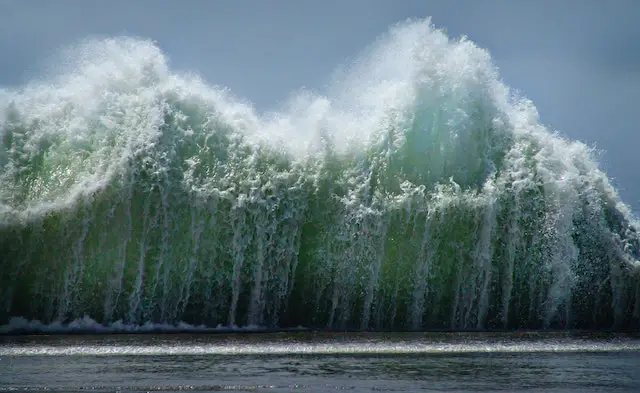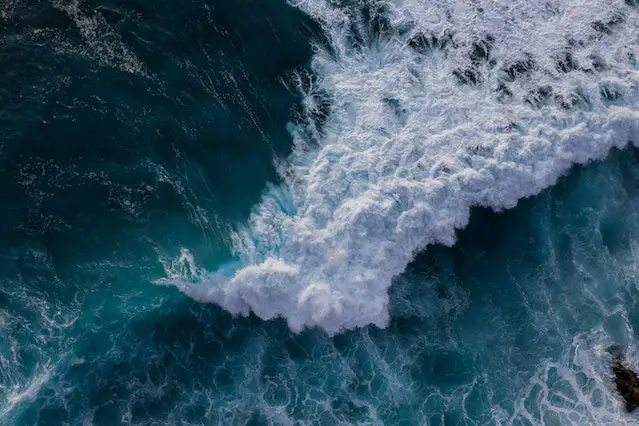
Tsunamis are some of the most powerful and destructive natural disasters on Earth. Before a tsunami hits an area, there are often warning signs that can alert people to the impending danger.
These warning signs can help save lives if people know what to look for and how to respond.
By understanding what happens before a tsunami strikes, people can prepare themselves and take steps to protect their safety.
What is a Tsunami?
A tsunami is a large ocean wave caused by an earthquake, volcano eruption, landslide, or meteorite impact.
It is a series of waves that can reach hundreds of feet in height and travel at speeds up to 500 miles per hour (800 km/h).
Tsunamis can cause severe damage to coastal areas as they move inland, flooding beaches, destroying buildings and homes, and claiming lives.
- Read also: What Causes Waves in the Ocean
- Read also: What Is the Freezing Point of Water
Overview of the Impacts of a Tsunami
Tsunamis can cause serious destruction and death due to the immense power of their waves.
In addition to physical damage, tsunamis can also cause tremendous economic impacts, such as: the loss of businesses, Jobs, and property values in affected areas.
The mental trauma caused by experiencing a tsunami can also have lasting psychological effects.
Warning Signs Before a Tsunami Occurs

There are several warning signs that may indicate a tsunami is about to strike an area. Pay attention to these warning signs, so you can be prepared:
Earthquake Activity
One of the most common signs that a tsunami is about to occur is an earthquake. If you feel the ground shaking, then it could be an indication of a potential tsunami coming soon.
It’s important to remember that even if the quake doesn’t seem very strong or last for very long, it may still indicate a possible tsunami in your area.
If an earthquake occurs in the ocean, it can cause a series of waves that may reach land as a tsunami.
Changes in Water Levels
Another sign of an impending tsunami is changing in water levels. This can mean rising or lowering tides or even rapid changes in the color of the ocean.
If you notice that water levels are suddenly different from what they were before, it could be an indication of a possible tsunami in your area.
Be sure to pay attention to the size and shape of waves, as well as the color of the water, when assessing changes in tide or ocean depth.
Sudden Large Waves
In some cases, a tsunami can be preceded by sudden large waves. These waves can be several feet high and may come in rapidly without any warning.
If you witness these types of waves, it could be an indication that a tsunami is approaching your area.
Pay attention to the size and frequency of the waves; if they seem unusually large and come in rapidly, it may be a sign that a tsunami is coming.
Animals Reacting Unusually
In some cases, animals can sense when a tsunami is about to occur.
If you notice animals behaving strangely or acting out of character, this could be an indication that a tsunami is coming.
Pay attention to the reactions of birds, fish, and other animals in your area, as they may be able to sense when a natural disaster is about to occur.
Strange Sounds Coming from the Ocean
In some cases, a tsunami can be preceded by strange sounds coming from the ocean.
These sounds may include loud roars or rumbling noises that can last for several minutes before the tsunami hits.
If you notice these types of noises, pay attention and take steps to ensure your safety.
How to Prepare for a Tsunami?

There are several steps that you can take to prepare for a possible tsunami. These include:
Stay Alert to Early Warning Signs
Be sure to pay attention to any warning signs of a possible tsunami, such as changes in water levels, sudden large waves, strange animal behavior, and loud noises coming from the ocean.
If you notice any of these signs, take steps to protect yourself and your property.
Know Your Evacuation Route
Be sure to familiarize yourself with evacuation routes in your area.
This will help you quickly and safely evacuate when a tsunami is on its way.
Be sure to have a plan in place that includes places you can go, items you’ll need, and how you will communicate with others during an emergency.
Have Emergency Supplies
It’s important to have emergency supplies on hand in case of a tsunami. This includes items such as food, water, first-aid kits, flashlights, and batteries.
Be sure to store these items in an easily accessible place in your home so you can quickly grab them if needed.
Take Shelter
If a tsunami is imminent, the best thing to do is to seek shelter. This can be indoors away from the coast, or in a sturdy building on higher ground.
Be sure to stay away from windows and doors, as these can easily shatter during a tsunami.
Be Prepared
By being aware of the warning signs of a possible tsunami and having a plan in place, you can ensure that you stay safe if a tsunami occurs.
Pay attention to the signs and take steps to protect yourself and your property.
- Read also: How Rare Are Shooting Stars
- Read also: Why is the earth’s core so hot
Conclusion

Tsunamis can be devastating, so it’s important to pay attention to the warning signs in order to prepare for them.
Warning signs of a possible tsunami include changes in water levels, sudden large waves, strange animal behavior, and loud noises coming from the ocean.
In order to prepare for a tsunami, stay alert to early warning signs, know your evacuation route, have emergency supplies on hand, and take shelter in a sturdy building on higher ground. By being aware of the warning signs and having a plan in place, you can ensure that you stay safe if a tsunami occurs.
Understanding and preparing for the risks associated with tsunamis can help reduce the devastating effects of these natural disasters.



